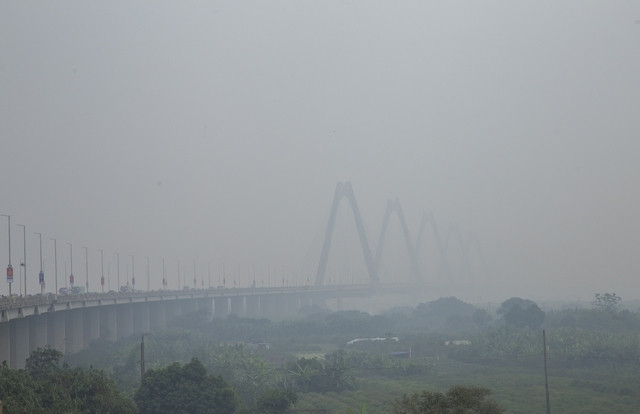Early this morning, many northern provinces such as Hanoi, Bac Ninh, Hung Yen, Ninh Binh, Nam Dinh, Thai Nguyen... had air pollution indexes at unprecedented high levels.
Early this morning (January 10), fog covered the entire Red River Delta, causing many provinces to have unprecedentedly high air pollution indexes. On PamAir's air quality measurement application, the AQI index of many localities reached the brown warning level (the highest level of pollution), with some places having this index at the highest level.
More than 80 real-time air quality monitoring stations of the PamAir Network recorded air quality mainly in purple (very bad, harmful to health), many measuring points remained at the brown threshold (the most serious, dangerous pollution threshold).

Fog covers many northern provinces causing serious air pollution.
Specifically, at 8:15 a.m., the point with the highest AQI index was Bai Dinh (Ninh Binh) at 500. This is the highest level on the air pollution index scale. Other areas with similarly high indexes include Gia Vien (Ninh Binh) AQI 439, Nam Dinh City AQI 356, Thai Nguyen City AQI 428, Ba Vi (Hanoi) AQI 361, Van Lam (Hung Yen) AQI 498, Gia Lam (Hanoi) AQI 356, My Hao (Hung Yen) AQI 341, Nam Dan (Nghe An) AQI 379...
In Hanoi, many areas have brown air pollution warnings - extremely harmful to health. Some areas have very high AQI indexes such as Cau Giay AQI 433, Pham Tuan Tai street 305, Hoa Sen Kindergarten AQI 451, Thanh Xuan AQI 318, Hoan Kiem AQI 376. In particular, Time City urban area has the highest AQI index of 500.
In the ranking of the world's most polluted cities this morning on the IQAir application of the US Embassy, Hanoi ranked 3rd with an average AQI index of 193.
Experts say the cause of this pollution is closely related to weather factors. Hanoi and the northern provinces are experiencing calm, cold, dry days. These conditions prevent pollutants from dispersing and instead concentrate in areas close to the ground, causing serious pollution.
Dr. Hoang Duong Tung, Vietnam Clean Air Network, said that photochemical smog is fog that occurs in the troposphere of the atmosphere, caused by the phenomenon of radiation temperature inversion (sunlight) causing temperature inversion combined with high humidity in the air, thereby accumulating and condensing existing pollutants in the air at high altitudes, creating photochemical smog, especially in inner-city areas. This phenomenon is harmful to human health and reduces visibility.
In addition, air pollution in Hanoi and other urban areas also comes from traffic emissions, construction, industrial production and other human activities. Air pollution in Hanoi as well as the northern provinces is mainly dust pollution. In particular, fine dust PM2.5 is considered "death" in the air and can penetrate deep into the lungs, causing many respiratory and cardiovascular diseases, especially for sensitive subjects such as the elderly and children.
According to the National Center for Hydro-Meteorological Forecasting, a strong cold front will arrive on January 15, and air quality will improve by then. From now until the weekend, many northern provinces will continue to experience air pollution due to dust that cannot be dispersed.
People participating in traffic and outdoor sports activities need to wear masks, glasses that cover the entire eye area and shield themselves from direct contact with polluted fog.
When traveling on the highway, vehicle users should limit speed, keep a safe distance, and turn on fog lights to ensure traffic safety. People need to use saline nasal drops, improve hygiene in their homes and lighting systems, limit drying food and clothes, and limit the use of rainwater...
According to Health and Life